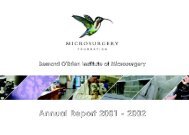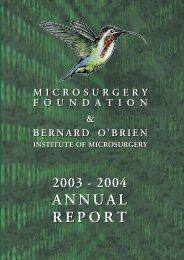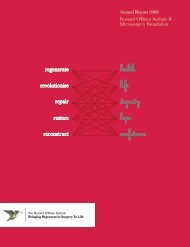annual report - O'Brien Institute
annual report - O'Brien Institute
annual report - O'Brien Institute
Create successful ePaper yourself
Turn your PDF publications into a flip-book with our unique Google optimized e-Paper software.
Overview<br />
Bernard O’Brien <strong>Institute</strong> of Microsurgery<br />
What is Microsurgery Research<br />
Microsurgery literally means operating through a<br />
microscope. In our field of Plastic and Reconstructive<br />
Surgery we use the microscope to connect small blood<br />
vessels (microsurgery) for the purpose of restoring<br />
circulation to amputated parts (replantation), or to tissues<br />
or parts that have been transferred from some other parts<br />
of the body (transplantation) such as skin, muscle, bones,<br />
joints, toes, etc.<br />
This experimental research is widely applied to clinical<br />
reconstructive microsurgery in trauma, cancer, burns and<br />
congenital abnormalities. This spectrum of activity covers<br />
all ages from infancy to the elderly and illustrates one of<br />
the most important developments in modern surgery.<br />
Currently we can join 0.5 mm diameter blood vessels<br />
using stitches one half the thickness of a human hair but<br />
there is still a risk that these vessels will clot off. When<br />
the circulation to a tissue is reduced or ceases a condition<br />
known as ischaemia, that tissue will atrophy or die occurs.<br />
The most familiar example of this is an ischaemic heart<br />
attack, but the same process occurs in strokes and<br />
gangrene of the limbs.<br />
At the Bernard O’Brien <strong>Institute</strong> of Microsurgery we are<br />
involved in research to understand the normal process of<br />
blood flow and factors which decrease it (ischaemia) or<br />
enhance it (angiogenesis). This will lead to new ways of<br />
reducing the effect of injury to tissues and to safer and<br />
more effective techniques of replantation, tissue<br />
transplants and even storage of tissue in tissue banks.<br />
By a better understanding of the process of blood flow<br />
and new blood vessel formation we will be able to help<br />
wounds heal, especially chronic ulcers, and be able to<br />
promote and manipulate the growth of tissues so that new<br />
parts can be manufactured in the body. This process has<br />
been termed “tissue engineering” and we have recently<br />
used this technique in humans to grow new ears and noses.<br />
Cancer growth and spread is dependent on new blood<br />
vessels and by understanding how this process works we<br />
can potentially inhibit new blood vessel formation. In<br />
breast cancer and melanoma models in mice we have been<br />
able to manipulate the cancer growth by using drugs<br />
which have shown to be important in switching on and off<br />
the angiogenic process.<br />
Following trauma nerves as well as blood vessels are<br />
commonly injured and microsurgery is used to repair them.<br />
Nerves which function in a very similar way to electric<br />
cables are composed of long fibres which are direct<br />
extensions from the nerve cells housed in the spinal cord.<br />
When a nerve is cut in the same way that tadpoles’ tails<br />
regrow, so too the nerve will grow out again from its point<br />
of injury. We are experimenting with ways to enhance the<br />
outgrowth of nerves following injury, particularly using a<br />
special growth factor “Leukaemia inhibitory Factor”.<br />
The work undertaken at Bernard O’Brien <strong>Institute</strong><br />
Microsurgery is broadly based and links many surgical<br />
disciplines and areas of applied science. Much<br />
collaborative work is in progress with other research<br />
institutes, both in Australia and overseas.<br />
Plastic and Reconstructive Surgery Unit<br />
The Plastic and Reconstructive Surgery Unit at St<br />
Vincent’s continues to be a leader in its field with 1,483<br />
patients having been admitted for treatment. The majority<br />
of these patients required surgery and of these, 479 were<br />
emergency patients with 429 requiring surgery from<br />
injuries caused by accidents.<br />
There were 31 replantation cases, the majority being<br />
fingers but also including a whole arm. 77 vascularised<br />
free tissue transfers were used for the reconstruction of<br />
major deformities, 30 of which were for head and neck<br />
cancer, 20 breast reconstructions and 17 for trauma. In<br />
all, 53% of cases involved the hand or an upper limb,<br />
31% general plastic surgery and the balance including<br />
facial, head and neck and burns reconstruction.<br />
The Research Fellows from the Bernard O’Brien <strong>Institute</strong><br />
of Microsurgery continue to be an integral part of our<br />
surgical teams and play an important role in the many<br />
difficult procedures that are undertaken by the Plastic<br />
and Reconstructive Unit at St Vincent’s. We are indeed<br />
indebted to the staff of the Plastic Surgery Unit at<br />
St Vincent’s Hospital for their help throughout the year.<br />
Professor Allan MacLeod<br />
many ‘genetically engineered’ mice available<br />
worldwide to answer crucial questions as to the<br />
molecules involved in angiogenesis.<br />
In the tissue culture laboratory we are currently<br />
investigating how nitric oxide (NO) regulates<br />
angiogenesis. We have recently established another<br />
model of angiogenesis in our laboratory. Pieces of<br />
vascular tissue are placed in a special gel in cell culture<br />
plates, and new blood vessel growth is observed over a<br />
2 week period. We are now about to test NO donors<br />
and inhibitors to observe their effect on vessel growth.<br />
In addition, we will test tissue from iNOS-/- mice to<br />
see if lack of NO via a genetic alteration confers<br />
different rates of vessel growth.<br />
Haemangioma Research<br />
We have begun examining the causes of<br />
haemangiomas, which occur when blood vessels<br />
spontaneously grow out of control. They are known<br />
to contain high levels of inflammatory cells such<br />
as mast cells. We have found that when these<br />
haemangiomas are placed in culture and exposed<br />
to FDA-approved. Lodoxamide, a mast cell stabiliser,<br />
there is regression of blood vessel growth. Mirna<br />
Boujaoude, PhD student, has recently joined our group<br />
and is involved in these studies, together with surgical<br />
fellows Drs. Tony Penington and Robert Donato.<br />
Engineering new blood vessels<br />
Another problem encountered by reconstructive<br />
surgeons is a lack of healthy blood vessels for use in<br />
repairing damaged tissues in trauma and cancer related<br />
reconstruction. We are trying to create a ‘bank’ of<br />
ready-to-use blood vessels that can be stored and taken<br />
“off the shelf” when required for reconstructive<br />
surgery. We have found that during storage blood<br />
vessels lose their internal lining of cells, which are<br />
essential for proper blood vessel function, particularly<br />
to stop blood clotting within the blood vessel.<br />
Therefore another tissue engineering project currently<br />
underway is investigating ways to restore these internal<br />
lining cells in stored blood vessels.<br />
Rabbit Stent Model<br />
Every year millions of Australians undergo heart<br />
bypass surgery. This involves replacing the blood<br />
vessels that supply the heart itself with new vessels<br />
taken either from the leg or the arm. The short-term<br />
success of this procedure is well documented however<br />
10 years later 50% of these patients need to have the<br />
MICROSURGERY<br />
FOUNDATION<br />
procedure repeated because the new vessels<br />
themselves become narrowed and occlude. We have<br />
developed a model in a rabbit where a polyester stent<br />
is wrapped around an implanted vessel in the groin<br />
and shown that the narrowing of the blood vessel<br />
over time is reduced. Further studies are needed but<br />
clinical implications are significant.<br />
14 27






